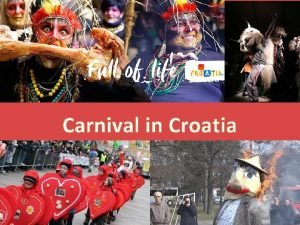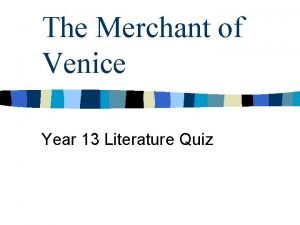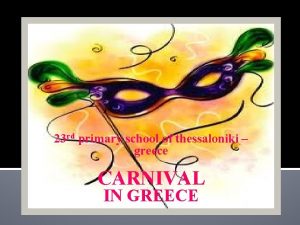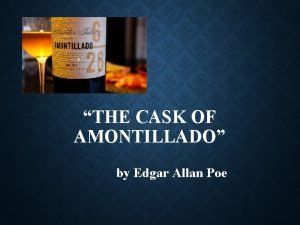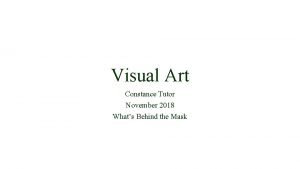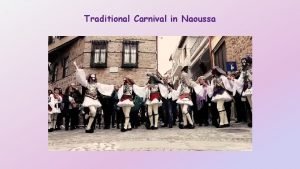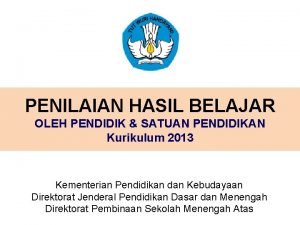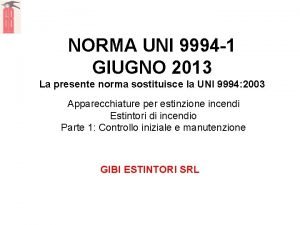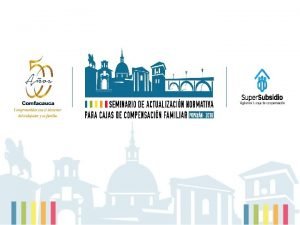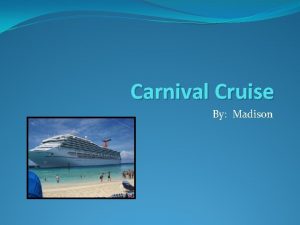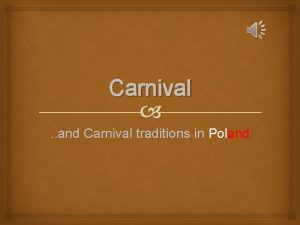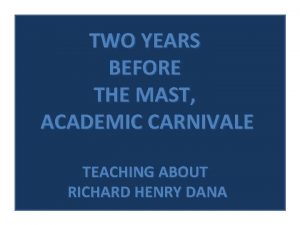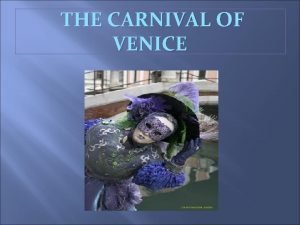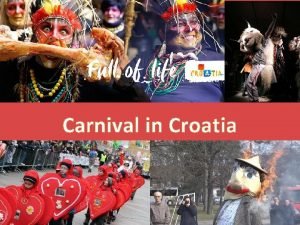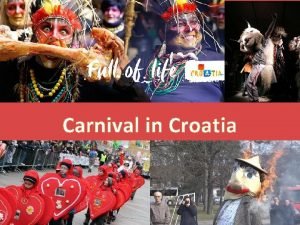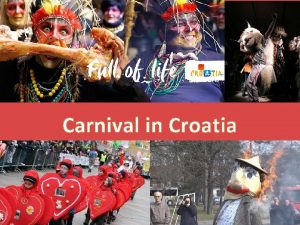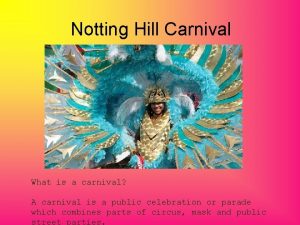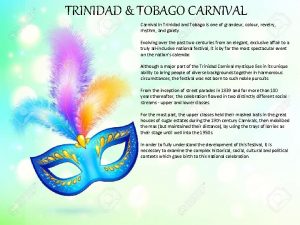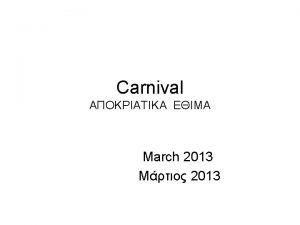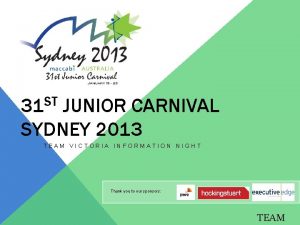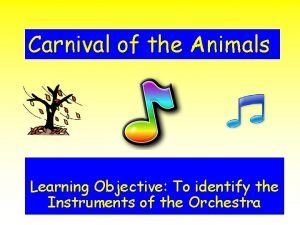c CARNIVAL 2013 Carnival or Carnivale is a






![Commedia dell'Arte Italian pronunciation: [komˈmɛːdja delˈlarte] Commedia dell'Arte Italian pronunciation: [komˈmɛːdja delˈlarte]](https://slidetodoc.com/presentation_image_h/0ffb7abf6f5b1bb44d9cfe01ebae7993/image-7.jpg)





















- Slides: 28

c. CARNIVAL 2013

Carnival, or Carnivale, is a festive season which occurs immediately before Lent; the main events are usually during February. Carnival typically involves a public celebration or parade combining some elements of circus, mask and public street party. People often dress up or masquerade during the celebrations, which mark an overturning of daily life.


The most famous Carnivals of Italy are those held in Venice, Viareggio, Ivrea and Acireale. The Carnival in Venice was first recorded in 1268. The subversive nature of the festival is reflected in Italy's many laws over the past several centuries attempting to restrict celebrations and the wearing of masks a central feature of the Carnival celebrations in Venice were halted for many years after the city fell under Austrian control in 1798, but were revived in the late 20 th century. The month-long Carnival of Viareggio is one of the most renowned in Europe, and is characterized mainly by its parade of floats and masks caricaturizing popular figures. In 2001, the town built a new "Carnival citadel" dedicated to Carnival preparations and entertainment.

The Carnival of Ivrea is famous for its Battle of the Oranges fought with citruses between the people by foot and the troops of the tyrant on the carts, to remember the wars that really happened during the Middle Ages. In the most part of the Archdiocese of Milan the Carnival lasts four more days, ending on the Saturday after Ash Wednesday, because of the Ambrosian Rite.

This year, in Sesto Fiorentino, Carnival was dedicated to Pinocchio, who was “born” here. The carnival period had been rich of games and labs for children, floats’ parades and a final masquerade party. A lot of shops partecipated at a “windows contest” and there was also a contest for the best “pinocchio pizza”.
![Commedia dellArte Italian pronunciation komˈmɛːdja delˈlarte Commedia dell'Arte Italian pronunciation: [komˈmɛːdja delˈlarte]](https://slidetodoc.com/presentation_image_h/0ffb7abf6f5b1bb44d9cfe01ebae7993/image-7.jpg)
Commedia dell'Arte Italian pronunciation: [komˈmɛːdja delˈlarte]

It is a form of theatre characterized by masked “types” which began in Italy in the 16 th century and was responsible for the advent of the actress and improvised performances based on sketches or scenarios. The closest translation of the name is “comedy of craft. Here, arte does not refer to "art" as we currently consider the word, but rather to that which is made by artigiani (artisans). Commedia dell'arte, conversely, was performed by professional actors (comici) who perfected a specific role or mask. The performers played on outside, temporary stages, and relied on various props ( robbe) in place of extensive scenery. The better troupes were patronized by nobility, and during carnival period might be funded by the various towns or cities, in which they played.

The characters of the commedia usually represent fixed social types, stock characters, such as foolish old men, devious servants, or military officers full of false bravado. Characters such as Pantalone the miserly Venetian merchant; Dottore Gratiano, the pedant from Bologna; or Arlecchino, the mischievous servant from Bergamo, began as satires on Italian "types" and became the archetypes of many of the favorite characters of 17 th- and 18 th-century European theatre. The commedia's genesis may be related to carnival in Venice, However, the connection to carnival (the period between Epiphany and Ash Wednesday) would suggest that masking was a convention of carnival and was applied at some point. The tradition in Northern Italy is centred in Mantua, Florence, and Venice, where the major companies came under the aegis of the various dukes. Concomitantly, a Neapolitan tradition emerged in the south and featured the prominent stage figure Pulcinella.

The florentine mask of comedy of craft

Stenterello is the typical florentine character: great talker, fearful and impulsive; but also wise, ingenious e ready to take sides with the most weak, although funk often hinders him. Together with the ready answer, he always has got prickly wisecrack, in florentine vernacular, not vulgar but mild and lively. In him is represented the florentine man of the people, of the lower class, who, oppressed by adversities and inequities, find always in himself the force for laughin and joking.

Dialogues of Comedy of craft are really funny, so they’re good for dramatization’s activities with the kids, especially in Nursery school. They’re really helpful when children have problems in relationship with adults and other children.

CARNIVAL AT “SCUOLA DELL’INFANZIA JEAN PIAGET”

Step 1. Every child of the school realized a big mask for school’s ornament with collage technique. They used several materials and distempers on paper bags filled with newspaper’s balls

Then we hung them from the ceiling

Step 2. the main project with 5 years old children for current year consists in activities inspired by the reading of “the wonderful wizard of oz”. during the carnival period every child realized his own mask of a character of the story.

Step 3. a group of children’s parents organized a school party on 8 th february which theme was “mostricini” (little monsters).

They prepared eight game points and entertained the children with music, books, games and drawings.






Step 4. On 12 th february (shrove Tuesday) children wore their masks and had a little music party after lunch to “prepare” themselves for parties that took place in the afternoon in the city centre and in several sporting or cultural associations

Also teachers like to celebrate!

step 5. At last, after ash Wednesday, they painted the mask they had wore this year at a carnival party.

webography http: //en. wikipedia. org/wiki/Carnival http: //en. wikipedia. org/wiki/Commedia_dell'arte http: //it. wikipedia. org/wiki/Stenterello

Jean piaget nursery school Sesto fiorentino March 2013
 Carnivale pronunciation
Carnivale pronunciation Carnival croatia
Carnival croatia What news does antonio recieve towards the end?
What news does antonio recieve towards the end? House on mango street edna's ruthie
House on mango street edna's ruthie Carnival akite
Carnival akite Jayden tittle
Jayden tittle Fortunato's carnival costume symbolizes
Fortunato's carnival costume symbolizes 90 students went to a school carnival
90 students went to a school carnival Cslide carnival
Cslide carnival What happens at carnival in brazil
What happens at carnival in brazil Carnival definition geography
Carnival definition geography Constance slides carnival
Constance slides carnival Naoussa's carnival
Naoussa's carnival Track changes in powerpoint 2013
Track changes in powerpoint 2013 Cultural dimensions ib psychology
Cultural dimensions ib psychology Contoh sikap spiritual dan sosial
Contoh sikap spiritual dan sosial Power pivot excel 2007
Power pivot excel 2007 Uni 9994-1 del 2013
Uni 9994-1 del 2013 Coso internal control integrated framework 2013 pdf
Coso internal control integrated framework 2013 pdf Nilai kkm pada kurikulum 2013
Nilai kkm pada kurikulum 2013 Ley 1636 de 2013 subsidio de desempleo
Ley 1636 de 2013 subsidio de desempleo Projektportalen trafikverket
Projektportalen trafikverket Standar kompetensi lulusan kurikulum 2013
Standar kompetensi lulusan kurikulum 2013 Backstage view word
Backstage view word Ipk pembelajaran abad 21
Ipk pembelajaran abad 21 Pengertian rumus slovin
Pengertian rumus slovin Backstage view word
Backstage view word Contoh cover dokumen 1 kurikulum 2013
Contoh cover dokumen 1 kurikulum 2013 Lista multinivel word 2013
Lista multinivel word 2013

